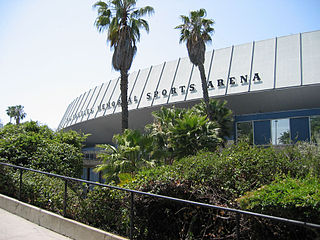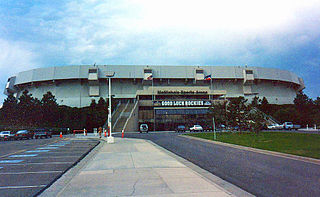
The Spirits of St. Louis were a basketball franchise based in St. Louis that played in the American Basketball Association (ABA) from 1974 to 1976. This was the third and last city of a franchise that had begun as a charter member in 1967 as the Houston Mavericks before a shift to the Carolinas in 1969 to play as the Cougars. They were one of two teams still in existence at the end of the ABA that did not survive the league's merger with the National Basketball Association (NBA). They were a member of the ABA in its last two seasons, 1974–75 and 1975–76, while playing their home games at the St. Louis Arena. Under terms of the ABA–NBA merger, the owners of the Spirits continued to receive a portion of NBA television revenue until 2014, when a revised agreement was reached with the league.

Meadowlands Arena is a closed indoor sports and concert venue located in the Meadowlands Sports Complex in East Rutherford, New Jersey, United States. Since closing, the state-owned facility has been used as a rehearsal stage by major concert-touring music stars and by NBCUniversal for television filming. The arena is located on New Jersey Route 120 across the highway from MetLife Stadium and the Meadowlands Racetrack, next to the American Dream shopping and entertainment complex.

Oakland Arena is an indoor arena located in Oakland, California, United States. From its opening in 1966 until 1996, it was known as the Oakland–Alameda County Coliseum Arena. After a major renovation completed in 1997, the arena was renamed The Arena in Oakland until 2005 and Oracle Arena from 2006 to 2019. It is often referred to as the Oakland Coliseum Arena as it is part of the Oakland–Alameda County Coliseum Complex with the adjacent Oakland Coliseum. Oakland Arena seats 19,596 fans for basketball.

The Spectrum was an indoor arena in Philadelphia, Pennsylvania. The arena opened in September 1967 as part of what is now known as the South Philadelphia Sports Complex. After several expansions of its seating capacity, it accommodated 18,168 for basketball and 17,380 for ice hockey, arena football, indoor soccer, and box lacrosse.

The Chicago Stadium was an indoor arena in Chicago that opened in 1929, closed in 1994 and was demolished in 1995. It was the home of the National Hockey League's Chicago Blackhawks and the National Basketball Association's Chicago Bulls. It was used for numerous other sporting events, opening with a championship boxing match in March 1929. The Stadium was built by Paddy Harmon, a promoter, who sank his entire fortune into the project, only to lose control to the Stadium shareholders, and leave his family nearly penniless a year later when he died. After exiting receivership in 1935, the Stadium was owned by the Norris and Wirtz families until its closure in 1994.

Kiel Auditorium was an indoor arena located in St. Louis, Missouri. It was the home of the Saint Louis University basketball team, and hosted the NBA's St. Louis Hawks from 1955 to 1968.

The Los Angeles Memorial Sports Arena was a multi-purpose arena at Exposition Park, in the University Park neighborhood of Los Angeles. It was located next to the Los Angeles Memorial Coliseum and just south of the campus of the University of Southern California, which managed and operated both venues under a master lease agreement with the Los Angeles Memorial Coliseum Commission. The arena was closed in April 2016, and was demolished in September of that same year. It was replaced with BMO Stadium, home of Major League Soccer's Los Angeles FC, which opened in 2018.

McNichols Sports Arena was an indoor arena located in Denver, Colorado, United States. Located adjacent to Mile High Stadium and completed in 1975, at a cost of $16 million, it seated 16,061 for hockey games and 17,171 for basketball games.

Market Square Arena was an indoor arena in Indianapolis. Completed in 1974, at a cost of $23 million, it seated 16,530 for basketball and 15,993 for ice hockey. Seating capacity for concerts and other events was adjusted by the use of large curtains which sealed off the upper rows. The arena closed down in 1999 and was demolished two years later.

Omni Coliseum was an indoor arena in Atlanta, Georgia, United States. Completed in 1972, the arena seated 16,378 for basketball and 15,278 for hockey. It was part of the Omni Complex, now known as the CNN Center.

The Met Center was an indoor arena that stood in Bloomington, Minnesota, United States, a suburb of Minneapolis. The arena, which was completed in 1967 by Minnesota Ice, just to the north of Metropolitan Stadium, seated 15,000. It was the home of the Minnesota North Stars of the National Hockey League (NHL) from 1967 to 1993. For its first 15 years, its official name was the Metropolitan Sports Center; the more familiar shorter name was adopted in 1982.

Pechanga Arena is an indoor arena in San Diego, California. The arena is home of the San Diego Seals of the National Lacrosse League (NLL), San Diego Strike Force of the Indoor Football League (IFL), and the San Diego Gulls of the American Hockey League (AHL).

Frederick L. Lewis is a retired American basketball player. He played professionally in the National Basketball Association (NBA) and American Basketball Association (ABA). He is the only player to start his career in the NBA, and play all 9 full ABA seasons (1967-1976) until the NBA/ABA merger, then sign back with the NBA.

The Enterprise Center is an 18,096-seat arena located in downtown St. Louis, Missouri, United States. Its primary tenant is the St. Louis Blues of the National Hockey League, but it is also used for other functions, such as NCAA basketball, NCAA hockey, concerts, professional wrestling and more. In a typical year, the facility hosts about 175 events. Industry trade publication Pollstar has previously ranked Enterprise Center among the top ten arenas worldwide in tickets sold to non-team events, but the facility has since fallen into the upper sixties, as of 2017.

The ABA–NBA merger was a major pro sports business maneuver in 1976 when the American Basketball Association (ABA) combined with the National Basketball Association (NBA), after multiple attempts over several years. The NBA and ABA had entered merger talks as early as 1970, but an antitrust suit filed by the head of the NBA players union, Robertson v. National Basketball Ass'n, blocked the merger until 1976.
Ozzie and DanielSilna are American businessmen of Latvian descent best known for their success in the textile industry, as well as being co-owners of the American Basketball Association's Spirits of St. Louis and the lucrative deal cut to fold that team during the ABA-NBA merger.

The city of St. Louis, Missouri, in the United States is home to more than a dozen professional, semi-professional, and collegiate sports teams. The Sporting News rated St. Louis the nation's "Best Sports City" in 2000 and the Wall Street Journal named it the best sports city in 2015.
The 1975–76 American Basketball Association season saw the Spirits of St. Louis, led by Marvin Barnes, Moses Malone, Ron Boone and Caldwell Jones, drop to sixth place in the ABA, with a record of 35–49. As a result, the Spirits missed the playoffs in their second and final season.

Sports in San Diego includes one major professional league team, other highest-level professional league teams, minor league teams, and college athletics. The San Diego Padres play in Major League Baseball (MLB). San Diego FC begins play in Major League Soccer (MLS) in 2025. San Diego State Aztecs teams play in NCAA Division I (FBS). The Farmers Insurance Open is a professional golf tournament on the PGA Tour, played annually at Torrey Pines Golf Course.





















